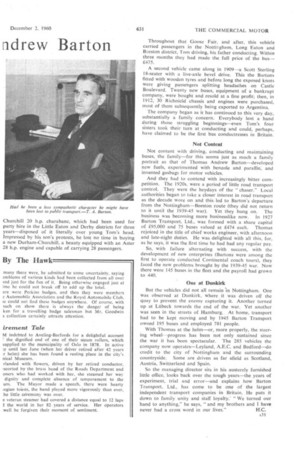Thom adrew Barton
Page 32

Page 33

If you've noticed an error in this article please click here to report it so we can fix it.
HAD he been a less sympathetic character, Thomas Andrew Barton, managing director of Barton Transport, Ltd., Chilwell, Notts. might have been lost forever to public transport. One of the many businesses in which his father, the late T. H. Barton, 0.B.E., took an interest, albeit with fluctuating success, was that of a Derby monumental mason. Young Tom was the salesman whose job it was to induce the bereaved to commemorate their loved ones in enduring marble. But the tears of widows and the cries of orphans were altogether too much for kindly Thomas, who did not take long to decide that monumental masonry, was not for him.
The years have not changed his disposition. Five minutes with him suffice to reveal his essential gentleness of mind. And if doubts were to linger, they would certainly be dispelled by any one of the thousand or so people on Barton Transport's payroll.
Here is an unpretentious yet undoubtedly successful man who disclaims any advantages of birth and education. His enterprising, restless, imaginative father was no believer in formal schooling. He pitched his sons into one undertaking after another and told them to learn their lessons there. Thomas was an apt pupil.
One could begin his story in Weston-super-Mare in 1900, when he was 12 years old. Having migrated there from Duffield, Derbyshire, where he owned a quarry, Mr. Barton, sen., bought a Daimler 6 h.p. 10-seater waggonette and plied between the Old and New Piers. But it seems convenient to skip those earliest days, spiced though they are by episodes in which such vehicles as an eight-seat Campion-Benz with two forward gears, Ile reverse, pneumatic tyres on the front wheels and solids at the rear play a prominent part, and pass on to the Nottingham Goose Fair of 1908.
Barton pere, who was nothing loath to sell anything provided a profit was in it for him, disposed of a Durham Churchill 20 h.p. charabanc, which had been used for party hire in the Little Eaton and Derby districts for three years—disposed of it literally over young Tom's head. Impressed by his son's protests, he lost no time in buying a new Durham-Churchill, a beauty equipped with an Aster 28 h.p. engine and capable of carrying 28 passengers.
Throughout that Goose Fair, and after, this vehicle carried passengers in the Nottingham, Long Eaton and Beeston district, Torn driving, his father conducting. Within three months they had made the full price of the bus— £475.
A second vehicle came along in 1909—a Scott Sterling 18-seater with a live-axle bevel drive. This the Bartons fitted with wooden tyres and before long the exposed knots were giving passengers splitting headaches on Castle Boulevard. Twenty new buses, equipment of a bankrupt company, were bought and resold at a fine profit; then, in 1912, 30 Richnield chassis and engines were purchased, most of them subsequently being exported to Argentina.
The company began as it has continued to this very day, substantially a family concern. Everybody lent a hand during those struggling beginnings—even Tom's four sisters took their turn at conducting and could, perhaps, have claimed to be the first bus conductresses in Britain.
Not Content
Not content with driving, conducting and maintaining buses, the family—for this seems just as much a family portrait as that of Thomas Andrew Barton—developed new fuels, experimented with benzole and paraffin', and invented gasbags for motor vehicles.
And they had to contend with increasingly bitter competition. The 1920s, were a period of little road transport control. They were the heydays of the "chaser." Local authorities began to take a closer interest in road transport as the decade wore on and this. led to Barton's departure from the Nottingham—Beeston route (they did not return to it until the 1939-45 war). Yet they hung on. The business was becoming more businesslike now. In 1927 Barton Transport. Ltd., was formed with a share capital of £95,000 and 75 buses valued at £474 each. Thomas rejoiced in the title of chief works engineer, with afternoon and late-night duties. He was delighted with all this, for, as he says, it was the first time he had had any regular pay.
So, with failure alternating with success, with the development of new enterprises (Bartons were among the first to operate conducted Continental coach tours), they faced the new problems brought by the 1939-45 war. Now there were 145 buses in the fleet and the payroll had grown to 440.
One at Dunkirk But the vehicles did not all remain in Nottingham. One was observed at Dunkirk, where it was driven off the quay to prevent the enemy capturing it. Another turned up at Lfibeck towards the end of the war. Yet another was seen in the streets of Hamburg. At home, transport had to be kept moving and by 1945 Barton Transport owned 195 buses and employed 781 people.
With Thomas at the helm—or, more properly, the steering wheel—progress has been not only sustained since the war it has been spectacular. The 285 vehicles the company now operates—Leyland, A.E.C. and Bedford—do credit to the city of Nottingham and the surrounding countryside. Some are driven as far afield as Scotland, Austria, Switzerland and Spain.
So the managing director sits in his austerely furnished little office, looks back over the tough years—the years of experiment, trial and error—and explains how Barton Transport, Ltd., has come to be one of the largest independent transport companies in Britain. He puts it down to family unity and staff loyalty."We turned our hand to anything," he says, "and my brothers and I have
never had a cross word in our lives." H.C.




















































































































